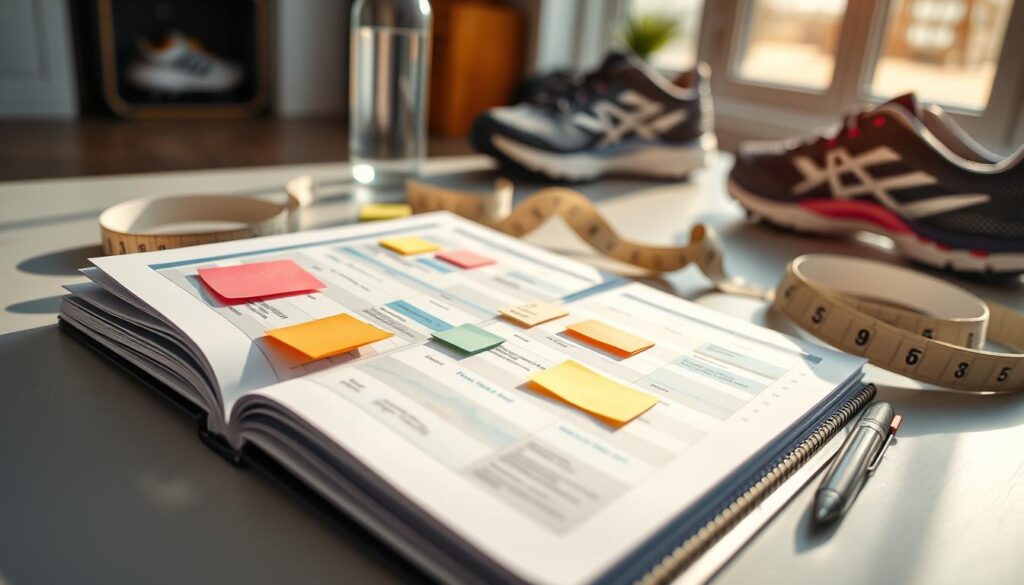Starting a journey to better health and fitness can be thrilling and scary. You might want to lose weight, get stronger, or feel better overall. To reach your fitness goals, you need to be dedicated and have a good plan. This guide will share 10 key tips to help you succeed in your health and fitness goals.

These strategies will help you make lasting changes. By learning how to set fitness goals and adopting healthy habits, you can overcome challenges and see progress. Let’s explore the important steps to help you achieve your fitness dreams and live a healthier, happier life.
Key Takeaways
- Set clear, measurable fitness goals
- Create a realistic timeline for achieving your objectives
- Develop a consistent exercise routine
- Focus on proper nutrition to support your fitness journey
- Seek professional guidance when needed
- Track your progress and stay motivated
- Build healthy habits for long-term success
Ways on How to Achieve My Fitness Goal: Understanding the Basics
Starting your fitness journey is both exciting and a bit overwhelming. Knowing the basics is essential for success. Let’s look at how to set yourself up for success.
Setting Clear and Measurable Objectives
Having a specific goal is key when starting your fitness journey. Instead of saying “I want to get fit,” aim for something like “I want to run a 5K in under 30 minutes.” This makes your goal clear and achievable.

Understanding Your Current Fitness Level
Before you start, find out where you are now. Knowing your current fitness level is important. It helps you pick exercises that fit your abilities and avoid injuries. A simple fitness test or talking to a trainer can give you this information.
Creating a Realistic Timeline
Fitness doesn’t happen overnight. Set a timeline that’s realistic and achievable for your goals. If you’re new to exercise, start with small, consistent goals. Remember, steady progress is better than rushing.
- Start with short-term goals (1-3 months)
- Plan medium-term objectives (3-6 months)
- Envision long-term aspirations (6+ months)
By understanding these basics, you’re building a strong foundation for your fitness journey. Remember, every step forward is progress, no matter how small it seems.
Creating SMART Fitness Goals That Actually Work
Setting goals is key to success in your fitness journey. The SMART framework helps you create goals that drive real progress. SMART stands for Specific, Measurable, Achievable, Relevant, and Time-bound.
Specific goals clarify exactly what you want to achieve. Instead of “get in shape,” aim for “run a 5K.” Measurable goals let you track progress. Make it measurable by setting a target time for your 5K run.
Achievable goals push you without being unrealistic. If you’re new to running, a marathon might be too ambitious. Start with short-term goals like a 5K. Relevant goals align with your overall fitness vision. If weight loss is your main aim, running fits well.
Time-bound goals have deadlines. Set a date for your 5K run to stay motivated. This approach works for various fitness goals. Want to lift weights? Set a goal to increase your bench press by 10 pounds in 8 weeks.
Remember, SMART goals boost your chances of success. They provide clear direction and motivation. Start small, celebrate wins, and adjust as needed. With SMART goals, you’re on track for lasting fitness success.
The Power of Consistent Exercise Routines
A solid exercise routine is the foundation of a successful fitness journey. Regular workouts build strength, improve heart health, and boost well-being. The secret is to create a plan that matches your lifestyle and goals.
Building a Sustainable Workout Schedule
Begin by planning to exercise three times a week. This schedule allows for enough rest while keeping you active. Make sure to spread out your workouts, avoiding back-to-back days to avoid burnout and injury.
Mixing Cardio and Strength Training
A good routine mixes cardio and strength training. Add resistance training to build muscle and increase metabolism. Try this simple split:
- Day 1: Cardio
- Day 2: Upper body strength training
- Day 3: Lower body strength training
Recovery and Rest Days
Rest is vital for muscle repair and growth. Make sure to include rest days between workouts to avoid exhaustion and overtraining. Use these days for light activities like stretching or walking to stay active without overdoing it.
Remember, consistency is key. Stick to your routine, and you’ll see improvements over time. Adjust your plan if needed, but always prioritize regular workouts for the best fitness results.
Nutrition Strategies for Optimal Fitness Results
Healthy eating is key to reaching your fitness goals. To lose weight and cut body fat, eat balanced meals. These meals should fuel your workouts and help you recover. Start your day with a nutritious breakfast, like a fruit smoothie with someone you care about, to kickstart your metabolism.
Add lean proteins, whole grains, and lots of fruits and vegetables to your diet. These foods give you the nutrients you need and keep you full longer. Use smaller plates for portion control to avoid eating too much.
Drink water all day to stay energized and support your body’s functions. Try to eat meals around your workouts to boost performance and recovery.
- Eat a light meal 2-3 hours before exercising
- Have a small snack 30 minutes post-workout
- Consume a balanced meal within 2 hours after exercise
Remember, losing weight in a healthy way means eating fewer calories through diet and exercise. Don’t go for crash diets or extreme eating plans. They can be bad for your health and slow down your progress. Instead, aim for lasting, healthy changes in your eating habits that support your fitness journey.
The Role of Professional Guidance in Fitness Success
Getting fit is easier with expert help. A personal trainer brings knowledge and motivation to your workouts. They create fitness programs tailored to your needs and abilities.
Working with Personal Trainers
A certified personal trainer does more than just teach you exercises. They offer accountability, support, and expert guidance. Personal trainers help you set realistic goals and develop strategies to reach them.
Understanding Exercise Science
Exercise physiologists apply scientific principles to fitness. They study how the body responds to physical activity. This knowledge helps create effective workout plans that maximize results and minimize injury risk.
Creating Personalized Workout Plans
A well-designed fitness program considers your unique needs and goals. Personal trainers assess your current fitness level, health history, and lifestyle. They use this information to create a workout plan that fits your schedule and preferences.
- Customized exercises based on your abilities
- Progressive overload to ensure continuous improvement
- Variety to prevent boredom and plateaus
- Proper form and technique instruction
Professional guidance can make a big difference in your fitness journey. Whether you’re just starting or looking to break through a plateau, a personal trainer or exercise physiologist can help you achieve your goals safely and effectively.
Tracking Progress and Maintaining Motivation
Staying motivated to exercise can be tough, but tracking your progress is a game-changer. It helps you stay focused on your fitness journey and provides tangible evidence of your hard work. Let’s explore some effective ways to keep you motivated and on track.
Use a fitness app or journal to record your workouts. This simple habit can help you stay accountable and motivated to exercise regularly. Seeing your improvements over time is a powerful motivator.
Set mini-goals along the way to your main objective. Celebrating these small wins can keep you motivated and focused on the bigger picture. Try rewarding yourself with a massage or new workout gear when you hit these milestones.
- Take progress photos
- Measure body measurements
- Log your workout performance
- Track your energy levels
Find a workout buddy or join a fitness community. Having support from others can help you stay committed to your goals. Share your progress, challenges, and victories with like-minded individuals who understand your journey.
Remember, motivation fluctuates. On days when you feel less enthusiastic, focus on discipline. Stick to your routine, even if you don’t feel like it. This consistency will help you stay motivated in the long run and bring you closer to your fitness goals.
Building Healthy Habits for Long-Term Success
Creating lasting fitness habits is key to achieving your health goals. It takes about 66 days to form a new habit. So, patience and persistence are crucial. By establishing daily routines and treating fitness as ‘me time’, you can build a sustainable path to wellness.
Creating Daily Routines
Incorporate your exercise of choice into your daily schedule. Whether it’s a morning jog or evening yoga, consistency is vital. Make it a non-negotiable part of your day, just like brushing your teeth.
Developing Mental Resilience
Building mental toughness is as important as physical strength. Set small, achievable goals to boost confidence. Celebrate victories, no matter how small, to stay motivated on tough days.
Establishing Support Systems
Find a workout buddy or join a fitness class. This provides an opportunity for a good gossip while staying accountable. Share your goals with friends and family who can offer encouragement and support.
- Set a specific time for daily workouts
- Track your progress to stay motivated
- Join a fitness community for support
- Reward yourself for sticking to your routine
By focusing on these aspects, you’ll build a strong foundation for long-term fitness success. Remember, it’s not just about reaching a goal, but creating a lifestyle that supports your health and well-being.
Overcoming Common Fitness Obstacles
Starting a fitness journey is exciting, but it’s not always easy. Some days, you might feel like skipping workouts. The key is to know these obstacles and find ways to beat them.
Managing your time is a big challenge. When life gets hectic, it’s easy to miss workouts. Try treating your gym sessions as important meetings. This helps you stay consistent.
Hit a plateau? Don’t worry, it’s normal. To get past it, try new exercises or increase the intensity. Changing your routine keeps your body challenged.
- Set small, achievable goals
- Track your progress
- Reward yourself for milestones
- Find a workout buddy for accountability
Setbacks happen. If you miss a workout or eat unhealthy food, don’t give up. Just get back on track with your next workout or meal. Consistency is key to lasting success.
Incorporating Variety to Prevent Workout Plateaus
Keeping your fitness routine fresh is key to staying motivated and seeing results. When you get bored with your workouts, it’s time to try something new. Mixing things up can reignite your passion for exercise and help you break through plateaus.
Trying New Exercise Modalities
Don’t limit yourself to one type of workout. If you usually go for a run, consider trying yoga or swimming. Each new exercise challenges your body in different ways, helping you build overall fitness. Here are some ideas to spice up your routine:
- Dance classes
- Rock climbing
- Martial arts
- Cycling
Cross-Training Benefits
Cross-training involves mixing different types of exercise in your routine. This approach can improve your overall fitness and reduce the risk of injury. For example, if you’re a runner, adding strength training can boost your performance and prevent overuse injuries.
Seasonal Workout Adjustments
Changing your workouts with the seasons can keep things interesting. In summer, you might go for a run outdoors or try open-water swimming. Winter could be perfect for indoor rock climbing or hot yoga. By adapting to the weather, you’ll never get bored with your fitness routine.
Remember, the key to long-term fitness success is enjoying what you do. Don’t be afraid to experiment with new exercises until you find what works best for you.
The Mind-Body Connection in Fitness Achievement
Your mind is key in your fitness journey. Exercise releases endorphins, making you feel good. This feeling boosts your motivation and helps you reach your fitness goals.
Being mindful during workouts can make your experience better. By focusing on your breath and movements, you become more aware of your body. This awareness helps you listen to your body, preventing injuries and improving performance.
Managing stress is also important in the mind-body connection. Regular exercise can lower stress levels, improving your mental health. This positive cycle keeps you committed to fitness and a healthy lifestyle.
- Pay attention to how exercise affects your mood
- Use mindfulness techniques during workouts
- Incorporate stress-reducing activities into your routine
Remember, fitness is more than physical strength. It’s about building a positive mind-body relationship. By understanding this connection, you can achieve your fitness goals in a balanced and sustainable way.
Conclusion
Reaching your fitness goals is a journey that needs dedication, planning, and hard work. Setting clear goals and sticking to a routine helps you succeed. Remember, what you eat is just as important as how you exercise.
Getting help from trainers or experts can make a big difference. They can create plans just for you. Keeping track of your progress and staying motivated are also key. Building good habits and overcoming challenges will help you succeed in the long run.
Make sure to mix up your workouts to avoid getting stuck. Trying new things can keep you excited and improve your fitness. Also, don’t underestimate the power of your mind in reaching your fitness goals. With these tips, you’re ready to start your fitness journey and make lasting changes to your health.




3 Comments
Pingback:
November 23, 2024 at 1:12 amPingback:
November 27, 2024 at 9:22 pmPingback:
November 27, 2024 at 10:22 pm